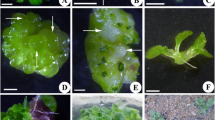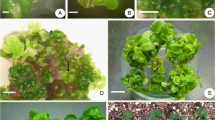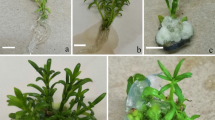Summary
An efficient and simple plant regeneration system via organogenesis from leaf segments of persimmon (Diospyros kaki Thunb.) cultivars ‘Fuyu’ and ‘Nishimurawase’ has been developed. The regeneration capacity was influenced by the culture vessels, gelling agents, plant growth regulators, and light conditions. Leaf explants taken from in vitro shoots were cultured on a modified Murashige and Skoog medium (MS1/2N), for 16 wk without transfer to fresh medium. Adventious shoots appeared after 4 and 8 wk in culture of ‘Nishimurawase’ and ‘Fuyu’ tissues, respectively. The culture of leaf explants in Erlenmeyer flasks with medium containing 4 g l−1 agar enhanced shoot formation in comparison to media with increased agar concentrations. Optimal shoot regeneration was obtained with 5 mg l−1 (22.8 μM) zeatin and 0.1 mg l−1 (0.05 μM) indole-3-butyric acid (IBA) for ‘Nishimurawase’, and 10 mg l−1 (45.6 μM) zeatin and 0.1 mg l−1 (0.05 μM) IBA for ‘Fuyn’. Shoot regeneration frequencies in both cultivars were 100%, and shoot numbers per explant reached up to 9.2 for ‘Nishimurawase’ and 2.2 for ‘Fuyu’. Dark incubation during the first 4–5 wk was the most effective condition to successfully influence shoot regeneration in both cultivars. While dark incubation was essential for adventitious shoot formation by ‘Fuyu’, it was only slightly beneficial to ‘Nishimurawase’. More than 80% of the regenerated shoots rooted within 4 wk on hormone-free MS1/2N demium after having been dipped for 30 s in 250 mg l−1 (1.1. mM) IBA solution.
Similar content being viewed by others
References
Buddendorf-Joosten, J. M. C.; Woltering, E. J. Components of the gaseous environment and their effects on plant growth and development in vitro. Plant Growth Reg. 15:1–6; 1994.
Korban, S. S.; O'Connor, P. A.; Elobeidy, A. Effects of thidiazuron, naphthaleneascetic acid, dark incubation and genotype on shoot organogenesis from Malus leaves. J. Hort. Sci. 67:341–349; 1992.
Kuvshinov, V.; Koivu, K.; Kanerva, A.; Pehu, E. Agrobacterium tumefaciens-mediated transformation of greenhouse-grown Brassica rapa ssp. oleifera. Plant Cell Rep. 18:773–777; 1999.
Miller, R. M.; Kaul, V.; Hutchinson, J. F.; Richards, D. Adventitious shoot regeneration in carnation (Dianthus caryophyllus, L.) from axillary bud explants. Ann. Bot. 68:563–568; 1991.
Murashige, T.; Skoog, M. A revised, medium for rapid growth and bioassay with tobacco tissue cultures. Physiol. Plant. 15:473–497; 1962.
Nakamura, Y.; Kobayashi, S.; Nakajima, I. Agrobacterium-mediated transformation and plant regeneration from hypocotyl segments of Japanese persimmon (Diospyros kaki Thumb) Plant Cell Rep. 17:435–440; 1998.
Schuerman, P. L.; Dandekar, A. M. Transformation of temperate woody crops: progress and potentials. Sci. Hort. 55:101–124; 1993.
Sugiura, A.; Tao, R.; Muravama, H.; Tomana, T. In vitro propagation of Japanese persimmon. Hort Science 21:1205–1207; 1986.
Tao, R.; Dandekar, A. M.; Uratsu, S. L.; Vail, P. V.; Tebbets, J. S. Engineering genetic resistance against insects in Japanese persimmon using the cryIA(c) gene of Bacillus thuringiensis. J. Am. Soc. Hort. Sci. 122:764–771; 1997.
Tao, R.; Murayama, H.; Moriguchi, K.; Sugiura, A. Plant regeneration from callus cultures derived from primordial leaves of adult Japanese persimmon. Hort Science 23:1055–1056; 1988.
Tao, R.; Sugiura, A. Adventitious bud formation from callus cultures of Japanese persimmon. Hort Science 27:259–261; 1992a.
Tao, R.; Sugiura, A. Micropropagation of Japanese persimmon (Diospyros kaki L.). In: Bajaj, Y. P. S., ed. High-tech and micropropagation. Biotechnology in agriculture and forestry, vol. 18. Berlin, Heidelberg, New York; Springer; 1992b:426–440.
Welander, M.; Maheswaran, G. Shoot regeneration from leaf explants of dwarfing apple rootstocks. J. Plant Physiol. 140:223–228; 1992.
Yamada, K.; Matsumoto, T.; Haruki, K. Adventitious bud formation from hypocotyl segments in seed of Japanese porsimmon. J. Jap. Soc. Hort. Sci. 64 (Suppl. 2):154–155; 1987.
Yokoyama, T.; Takeuchi, M. Organ and plantlet formation from callus in Japanese persimmon (Diospyros kaki). Phytomorphology 26:273–276; 1976.
Author information
Authors and Affiliations
Corresponding author
Rights and permissions
About this article
Cite this article
Choi, J.Y., Kim, H.J., Lee, C.H. et al. Efficient and simple plant regeneration via organogenesis from leaf segment cultures of persimmon (Diospyros kaki thunb.). In Vitro Cell.Dev.Biol.-Plant 37, 274–279 (2001). https://doi.org/10.1007/s11627-001-0049-3
Received:
Accepted:
Issue Date:
DOI: https://doi.org/10.1007/s11627-001-0049-3




